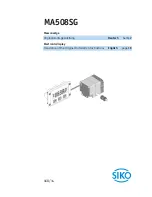
48
CHAPTER EIGHT
MEASURING SYSTEM ZERO (CALIBRATION)
8.1 Introduction
System zeroing is the method of calculating the time required for each
MAX II
and
transducer combination to detect the echo. When an echo travels back through the
bolt to the transducer face, there is an electronic delay before the
MAX II
detects the
echo. Because of differences in the electronic parts, or the transducer and cable, the
delay is slightly different for each combination of
MAX II
and transducer. The time
delay is called the
delay factor
or
zero time offset
.
The
MAX II
is designed for use with one or two calibration bars having a known
ultrasonic velocity and known length. Comparing their known physical length and
measured ultrasonic length determines the system delay factor, or zero time offset.
The system delay factor makes the Dakota Ultrasonics
MAX II
interchangeable with
all other calibrated
MAX II
systems.
Once the delay factor is determined, the
MAX II
software automatically subtracts it
from the apparent measurement of the time required for the sonic signal to travel
through the bolt. Thus, the actual time of signal travel is determined, and
compensation is made for the slight difference in each system. Since every
zeroed
MAX II
makes the same time measurement, the systems give the same result and
are interchangeable.
System Zeroing is only required if:
More
than
one
MAX II
or transducer will be used while measuring a set of bolts. If
the same
MAX II
and transducer are used, the amount of the delay is constant. If
unloaded length measurements were made with one
MAX II
, and the load
measurements were made with another, the difference in the delay factor could
cause an error, though in most cases the error would be very small. If it is
uncertain that the same unit and transducer will always be used, it is strongly
recommended that System Zeroing be checked whenever the
MAX II
used.
The application requires that the bolts be monitored over periodic intervals
through their service life. In this case, the
MAX II
must be zeroed in order to
maintain reliable and accurate measurements. Once again, If a transducer,
cable, or unit is replaced, the delay factor will change, resulting in erroneous
measurements.
8.2 Calibration / Zero misnomer
In the past there have been instances where users were under the impression that
zeroing the unit was the same as calibrating the unit. If the ultrasonic unit could
successfully measure the calibration blocks, the unit was calibrated. However, this is
not the case. The linearity of the unit and material type of the bolts are not calibrated
following a zero procedure
.
Summary of Contents for MAX II
Page 2: ......
Page 7: ......
Page 8: ......
Page 54: ...Dakota Ultrasonics 46 Figure 6 Reflection in a bending bolt ...
Page 215: ......
















































